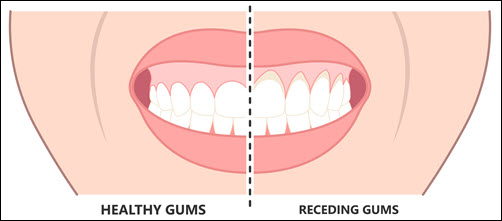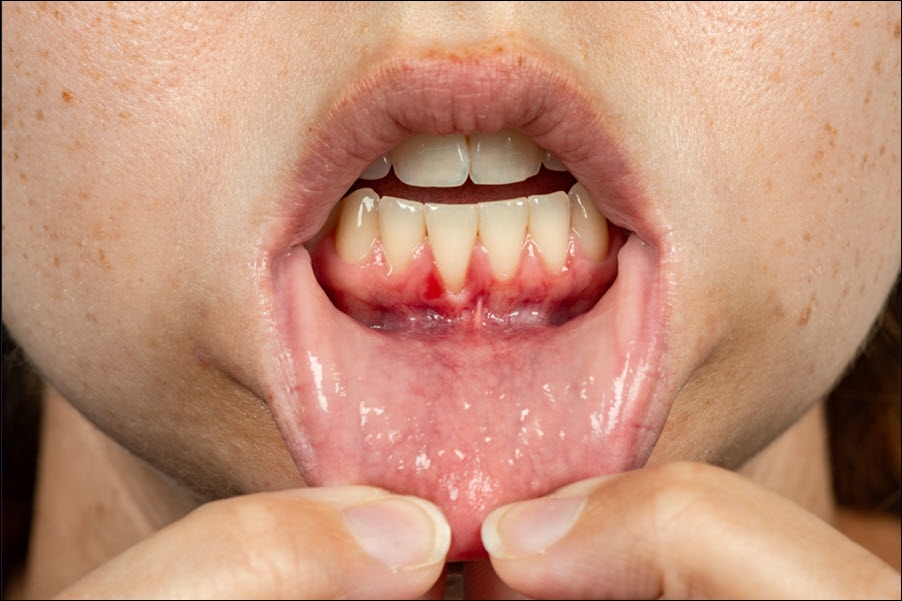Receding gums expose tooth roots and increase sensitivity. Plaque buildup, aggressive brushing, and gum disease cause gum recession. Exposed roots increase cavity risk and weaken tooth stability. Treating gum recession strengthens gum attachment and protects tooth roots. Professional cleanings remove plaque and reduce gum inflammation. Scaling and root planing smooth tooth roots and improve gum health. Proper brushing and flossing reduce gum strain and increase attachment strength. Soft tissue grafts restore lost gum tissue and improve smile appearance. Treating receding gums increases comfort and reduces sensitivity. Understanding how to treat gum recession improves overall dental health. Let’s explore the best ways to restore gum health and prevent further recession.
Professional Cleanings to Reduce Plaque and Inflammation
 Professional cleanings remove plaque and tartar from tooth surfaces and under the gumline. Plaque buildup irritates gums and increases recession risk. Dentists use ultrasonic tools to remove deep plaque without damaging enamel. Cleaning smooths tooth roots and improves gum attachment. Reduced inflammation increases gum strength and comfort. Professional cleanings reduce gum swelling and improve breath freshness. Early plaque removal prevents gum pockets from forming. Clean gumlines reduce sensitivity and increase tooth stability. Professional fluoride treatments strengthen enamel and improve gum health. Dentists recommend cleanings every six months to maintain gum strength. Proper cleaning increases gum health and reduces recession risk. Stronger gums improve overall dental strength and comfort.
Professional cleanings remove plaque and tartar from tooth surfaces and under the gumline. Plaque buildup irritates gums and increases recession risk. Dentists use ultrasonic tools to remove deep plaque without damaging enamel. Cleaning smooths tooth roots and improves gum attachment. Reduced inflammation increases gum strength and comfort. Professional cleanings reduce gum swelling and improve breath freshness. Early plaque removal prevents gum pockets from forming. Clean gumlines reduce sensitivity and increase tooth stability. Professional fluoride treatments strengthen enamel and improve gum health. Dentists recommend cleanings every six months to maintain gum strength. Proper cleaning increases gum health and reduces recession risk. Stronger gums improve overall dental strength and comfort.
Scaling and Root Planing to Treat Gum Pockets
Scaling and root planing treat deep gum pockets and improve gum attachment. Dentists clean plaque and tartar from below the gumline. Root planing smooths tooth roots and increases gum reattachment. Deep cleaning reduces gum inflammation and strengthens gum tissue. Reduced gum pockets increase tooth stability and reduce sensitivity. Professional monitoring ensures proper gum healing and attachment. Early treatment prevents further gum loss and tooth misalignment. Scaling reduces plaque buildup and bacterial growth. Smoother tooth roots improve gum health and bite strength. Regular monitoring increases gum strength and overall dental comfort. Scaling and root planing increase long-term gum health and protection.
Gum Grafting to Restore Receding Gums Lost Tissue
Gum grafting restores lost gum tissue and protects tooth roots. Dentists remove tissue from the roof of the mouth or a donor source. They place the graft over exposed tooth roots and secure it with sutures. The graft integrates with existing gum tissue, increasing coverage and strength to correct receding gums. Gum grafting reduces sensitivity and improves gum attachment. Proper healing increases gum stability and tooth strength. Professional monitoring ensures graft success and proper gum attachment. Stronger gum tissue improves tooth stability and chewing comfort. Reduced root exposure increases cavity resistance and bite strength. Gum grafting increases long-term gum health and smile strength. Stronger gums improve overall dental protection and comfort.
Using Desensitizing Toothpaste for Gum Sensitivity
Desensitizing toothpaste reduces tooth sensitivity caused by exposed roots. It contains compounds like potassium nitrate that block nerve signals. Brushing with desensitizing toothpaste twice daily reduces pain from hot and cold foods. Proper brushing technique protects gum tissue and reduces irritation. Desensitizing toothpaste strengthens enamel and improves root protection. Professional fluoride treatments increase enamel strength and reduce sensitivity. Soft-bristled toothbrushes reduce gum irritation and improve brushing comfort. Electric toothbrushes provide consistent pressure and protect gum tissue. Reduced sensitivity increases chewing comfort and overall dental health. Desensitizing toothpaste increases comfort and improves gum health. Better enamel protection increases long-term comfort and dental strength.
Avoiding Aggressive Brushing to Protect Gums
Aggressive brushing increases gum recession and enamel wear. Using a soft-bristled toothbrush protects gum tissue from pressure and irritation. Hold the toothbrush at a 45-degree angle to the gumline. Use small, circular motions to clean all tooth surfaces. Avoid brushing back and forth, which increases gum damage. Electric toothbrushes provide consistent pressure and reduce gum strain. Brushing for at least two minutes improves plaque removal and gum health. Better brushing technique increases gum attachment and reduces sensitivity. Stronger gums increase tooth stability and improve bite strength. Professional guidance improves brushing technique and protects gum health. Proper brushing increases gum strength and reduces recession risk.
Wearing a Mouthguard to Prevent Grinding Damage
Teeth grinding (bruxism) increases gum recession and enamel wear. Grinding pressure weakens gum attachment and increases sensitivity. A custom mouthguard protects teeth and gums from grinding damage. Wearing a mouthguard reduces jaw strain and tooth sensitivity. Soft guards cushion teeth and reduce gum pressure. Hard guards provide stronger protection for severe grinding. Professional adjustments improve guard fit and comfort. Wearing a mouthguard increases bite strength and chewing comfort. Reduced grinding increases gum strength and root protection. Proper alignment improves gum health and reduces recession risk. Mouthguards increase overall dental comfort and protection. Reduced grinding increases gum stability and overall mouth strength.
Improving Oral Hygiene to Strengthen Gums
Daily brushing and flossing protect gums from plaque buildup. Brushing twice daily with fluoride toothpaste strengthens enamel and gum attachment. Flossing removes plaque and food particles from between teeth. Water flossers provide an alternative for hard-to-reach areas. Rinsing with antibacterial mouthwash reduces plaque and gum inflammation. Professional cleanings increase plaque removal and improve gum health. Avoiding sugary and acidic foods reduces plaque buildup and gum sensitivity. Better nutrition increases gum strength and tissue healing. Increased gum strength improves tooth stability and bite comfort. Proper oral hygiene increases gum health and reduces recession risk. Stronger gums improve long-term dental health and comfort.
Treating Gum Disease to Prevent Further Recession
Gum disease increases gum recession and tooth sensitivity. Plaque buildup causes gum inflammation and weakens gum attachment. Professional cleanings remove plaque and reduce inflammation. Scaling and root planing treat deep gum pockets and improve gum attachment. Professional fluoride treatments strengthen enamel and reduce sensitivity. Antibiotic treatments reduce gum infections and improve healing. Improved oral hygiene increases gum strength and reduces plaque buildup. Early treatment prevents further gum loss and tooth misalignment. Stronger gums increase bite strength and overall comfort. Professional monitoring ensures proper gum health and alignment. Treating gum disease increases overall gum strength and dental health.
Boosting Confidence with Healthy Gums
Healthier gums increase smile strength and confidence. Stronger gum attachment increases chewing comfort and bite balance. Reduced plaque buildup increases breath freshness and gum health. Balanced gumlines improve smile symmetry and facial balance. Reduced sensitivity increases comfort with hot, cold, and sweet foods. Stronger gums increase confidence when speaking and eating. Proper gum attachment reduces tooth shifting and misalignment. Clean, healthy gums improve overall smile strength and comfort. Professional gum care increases long-term dental health and strength. Stronger gums increase comfort and personal confidence. Healthy gums improve both social and professional interactions.
Treating receding gums increases gum strength and tooth stability. Professional cleanings remove plaque and improve gum attachment. Scaling and root planing reduce inflammation and strengthen gum tissue. Gum grafting restores lost tissue and improves gum coverage. Desensitizing toothpaste reduces root sensitivity and improves comfort. Proper brushing technique protects gums and reduces irritation. Wearing a mouthguard reduces grinding pressure and increases gum strength. Improved oral hygiene increases gum health and plaque resistance. Professional care increases gum strength and overall dental health. Investing in gum treatment improves smile strength and bite comfort. Healthy gums increase both dental health and personal confidence.




